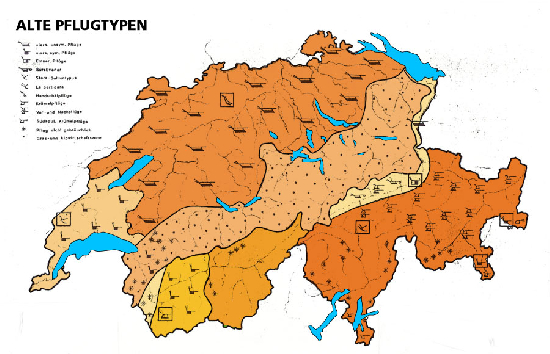
Der Pflug ist das wichtigste aller Ackergeräte und gilt als Symbol der Landwirtschaft schlechthin.
Er bezweckt gleichzeitig ein Lockern, Vermischen und Wenden des Bodens und bereitet diesen zur Aufnahme des Saatgutes vor.
Man unterscheidet verschiedene Pflugfahrten: Beim Herbst- oder Winterpflügen erfolgt eine tiefe Lockerung der Erde, die in rauer Furche bis zum Frühjahr liegen bleibt (Bodengare). Das Saatpflügen findet für Winterfrucht im Herbst, für Sommergetreide und Brachfrüchte (Kartoffeln, Rüben) im Frühling statt, wobei häufig auch Dünger mit untergebracht wird. Das oberflächliche Stoppelpflügen (Stürzen, Schälen, Strauchen) bringt Erntestoppeln zu rascher Verwesung und Unkrautsamen zum Auskeimen.
Der Gebrauch eines Pfluges war eng an den Besitz von Zugtieren gekoppelt; ein im Mittelland gebräuchlicher «Räderpflug» erforderte drei bis vier Ochsen oder zwei Pferde. Fehlten jene, wurde Hackbau betrieben, eine Bewirtschaftungsform, die ganze Landstriche kennzeichnete (Teile des Berner Oberlandes, des Wallis, des Tessins). Die Pflugarbeit war auch namengebend für das Ackermass. Eine Juchart (ca. 1/3 Hektare) bezeichnete soviel Land, als man mit einem Joch Ochsen an einem Tag zu pflügen vermochte.
The plough is the most important of all farming utensils and is used as the main symbol for agriculture. The plough simultaneously loosens, mixes and turns up the earth and prepares the ground for sowing.
There are various reasons for using the plough: In autumn or winter, the earth is ploughed deeply to loosen the soil which is then left bare until spring. The ground is prepared for sowing in the autumn for seed that grows in winter, in the spring for summer corn and potatoes or carrots. Fertiliser is often added then.
A more superficial ploughing crushes corn stalks after harvesting, hastening their decay and encouraging weeds to germinate. The plough could only be used if there were animals available to harness in front of it – the most frequently used plough in the farming area was a “wheeled plough”, for which three to four oxen or two horses were needed to pull it.
Otherwise man had to turn the earth by hand, using a hoe, a farming practice that was typical for large areas of Switzerland (parts of the bernese Oberland, the Wallis and the Tessin). Working with a plough also created measures for the size of a field. The German word “Juchart” (about 1/3 of a hectare) described the amount of land that could be ploughed with a team of oxen in one day. (The German word “Joch” -> yoke)
Visit the unique collection
in the plow museum in Guntmadingen,
Reservation by telephone required.
Tel. +41 (0) 79 352 42 65